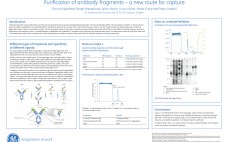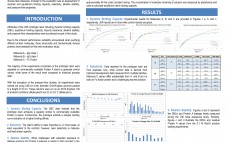Contract manufacturer DSM Biologics — at its current good manufacturing practices (CGMP) facility in Groningen, The Netherlands — provides services for clinical development and commercial production based on mammalian cell culture technology (Photo 1). During the 2011–2012 year, the facility went through a major expansion project to enlarge its capacity and fulfill a growing customer demand. From a business point of view, the project had a well-defined target for future production capacity as well as investment volume. Photo 1: Photo…
Downstream Processing
Performance of a Salt-Tolerant Membrane Adsorber in Flow-Through Mode
Monoclonal antibodies (MAbs) have become the most prevalent therapeutics in the biopharmaceutical industry. Their downstream purification typically involves protein A chromatography as a capture step followed by one or two additional chromatographic polishing steps. Additional unit operations dedicated specifically for viral clearance (e.g., viral inactivation and filtration) are added to ensure product safety. According to a survey of Amgen processes, after processing through a protein A column, only trace amounts of impurities such as Chinese hamster ovary cell protein (CHOP)…
Evaluation of a New Single-Use UV Sensor for Protein A Capture
As the adoption of single-use systems continues to expand beyond bags and tubing to complete process steps, a full range of sensing technologies will be needed to complement the resulting varied single-use applications. Single-use sensors must meet or exceed the performance of traditional sensing technologies in areas such as accuracy, response time, ease of use, control system integration, process compatibility, regulatory requirements, and cost. Single-use flow-through process sensors are currently available for pressure, temperature, flow, and conductivity. Here, we report…
Preformulation Development of a Recombinant Targeted Secretion Inhibitor
Our company carried out a preformulation study on a recombinant targeted secretion inhibitor (TSI) with contract research organization (CRO) Avacta Analytical. In this protein, the binding domain of botulinum toxin is replaced to broaden the toxin’s therapeutic potential and allow drug development to be targeted towards a specific disease. In our study, we took advantage of the high-throughput, microvolume protein analysis of Avacta’s Optim 1000 fluorescence and light-scattering instrument (which is distributed in the United States by Pall Corporation). It…
Rapid Detection of Pandemics
A Coronavirus — like severe acute respiratory syndrome (SARS) — is back in the headlines. On returning from a trip to Saudi Arabia in summer 2012, a Qatari national was struck down by a mystery respiratory illness. Because of inadequate diagnostic capabilities, the patient was transferred from Qatar to London for intensive-care treatment and diagnosis. The UK Health Protection Agency (HPA) confirmed infection with the same Coronavirus strain discovered by a Dutch team following the death of a Saudi national…
Comparison of Commercial Kits for Extraction of Residual Host Cell DNA
Expression of therapeutic proteins in cultured cells is a cost effective method for production of commercial quantities of a drug substance. However, the manufacturing and purification process of these products leaves the potential for DNA contamination from the host cells. Due to the theoretical potential for the transfer of oncogenes from the host cell, the WHO has set a residual host cell DNA limit of 10ng/dose in biologic therapeutics. Regulatory agencies have set allowable limits between 100pg/dose and 10ng/dose depending…
New Core Bead Chromatography Medium Enables Group Separation and High Productivity Purification of Large Molecules
When large biomolecules such as IgM or influenza virus are purified, group separation with gel filtration is the most commonly used technique. Advantages of using gel filtration include the high purity and the high recoveries that can be achieved, while a drawback is the relatively low productivity. Captoâ„¢ Core 700 is a chromatography medium (resin) from GE Healthcare Life Sciences designed with core bead technology. The core bead technology enables double functionality for Capto Core 700 – size exclusion and…
Purification of Antibody Fragments: A New Route for Capture
Antibody fragments have the potential to become the next important class of protein-based biotherapeutics after monoclonal antibodies (MAbs). The introduction of Captoâ„¢ L, with its protein L ligand, provides a possibility for an industrial platform purification approach for capture of this class of biomolecules. Capto L can bind a broad range of antibody fragments containing kappa light chains. Capto L is the latest member of chromatographic media (resins) in the toolbox consisting of several different products with affinity for the…
Evaluation of a Novel Polymer Based Protein A Resin for the Capture of Immunoglobulins and Fc-Fusion Proteins
In the biopharmaceutical industry ever increasing monoclonal antibody titers in cell culture have necessitated discovery of more efficient Protein A capture operations, realized in terms of higher binding capacity, faster throughput, increased resin lifetime, and decreased cost of goods. Recent changes in the Protein A intellectual property landscape have invited new competitors to enter this market. Given the increased availability of new Protein A technology, Biogen Idec has evaluated a prototype resin being developed by JSR Life Sciences known as…
AbSolute® High Cap by Novasep: Revolutionary Protein A Media
Novasep has developed AbSolute® High Cap, an optimized silica-based protein A media for the capture of monoclonal and polyclonal antibodies. This protein A media is adapted to all fermentation volumes while offering the highest dynamic and static binding capacities (DBC10% ≥ 60 mg/mL, SBC ≥ 95 mg/mL) and, as a result, high productivities at all velocities. By decreasing the amount of resin required to downstream a feed (30-50% less), AbSolute® High Cap enhances the robustness of the protein A capture…





